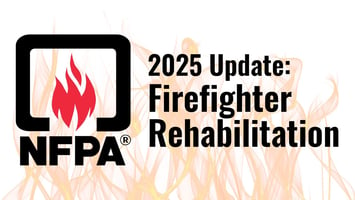We'll give you a hint... It's not what you think!
Why don't firefighters want to go to rehab?
It might actually be YOUR fault they don't want to go! But WearARMR can help.
Last week at the National Conference on EMS, we heard this comment more than any other; we talked to hundreds of EMTs and firefighters, line officers and members, newbies and veterans, and almost everyone expressed frustration about those needing to go not wanting to go to firefighter rehab. The diverse group also gave us the opportunity to ask firefighters and officers why they wouldn't want to go get checked out, and here's what we found:
1. Rehab is usually chaotic and disorganized.
Firefighters are a checklist-oriented group, with procedures and policies for almost everything. Hoses and equipment are always put back the same way and things are usually done for a reason. Moving from the "business end" of a fire scene into a rehab area that 1) looks different at every incident, 2) has no easily discernable system, and 3) is usually more than a little haphazard instills no confidence in the rehab process whatsoever.
Most agencies we asked to tell us about their "rehab system" simply listed equipment and how to set it up, then said "then we run rehab." But what IS that? Usually only the more senior member could tell us, and even then only two out of the hundreds of people we talked to would trust absolutely anyone on their team to run rehab. As a result, rehab areas are usually highly inefficient with firefighters languishing for seemingly forever.
- Firefighter rehab needs to look the same every time, so firefighters know what to expect. Adopting a system like WearARMR would make the rehab process repeatable.
- Firefighter rehab needs to be an idiot-proof system, not a jumbled mass of "Where's the blood pressure cuff? Who took his vitals last and when?" WearARMR doesn't leave anything up to prior or on-the-spot training, as it truly is idiot-proof.
2. They think rehab is keeping them FROM the fight.
Firefighters sign up to fight fires, not sit in chairs. FOMO (fear of missing out) is real on a fire scene, so firefighter rehab is seen as a punishment or (at the very least) purgatory. What firefighters don't hear very often is WHY they need to go to rehab and why rehabilitation is important: high-quality rehab keeps them IN the fight.
The #1 killer of firefighters is heart attacks and other overexertion/stress injuries/illnesses; unless firefighters have seen or experienced what it's like to have an on-duty fatality in their department, it's an existential threat. There's been a significant push recently to screen firefighters from cancer, to wipe down with special wipes after each call, and more (all of which are amazing developments), but there hasn't been a similar nation-wide focus on adoption of firefighter rehab systems.
- Firefighter rehab needs to be relevant to firefighters, so they understand we're trying to extend their length of service on the current call AND for even more years to come. WearARMR training tries to hammer this point home through case studies and statistics.
- Shift the mentality, because not going to firefighter rehab puts OTHERS at risk. If she collapsed of exhaustion or a heart attack in a dangerous location, others would need to rescue her. If others were relying on him to watch their back and they got heat stroke, those others are on their own.
3. Line Officers don't set/enforce the expectations.
"Monkey see, monkey do" is a common refrain among frustrated EMS providers. Many mentioned the lack of buy-in from line officers like Chiefs, Captains, and Lieutenants, and those whose firefighters do go to rehab specifically mentioned how great the department's officers were at forcing the issue.
It's important to remember that not only is the Incident Commander (IC) responsible for ensuring incident rehabilitation exists on a scene, they're also responsible for ensuring the quality of the rehab provided. If the IC doesn't have confidence in the quality and efficiency of the rehab area, and sending firefighters there would result in effectively losing that firefighter for the rest of the incident, he may not be willing to send firefighters there.
There also usually isn't a way to check and see AFTER the incident whether or not people went to rehab, and to hold those who should've gone but didn't accountable for their actions. Paperwork is spotty at best and nobody quite knows who was supposed to go, in part because rehab areas don't use the same accountability tools used in other areas of the fireground (like accountability tags).
- Firefighter rehab needs to prioritize keeping proper accountability both in the moment on the scene and as a paper record to review later. WearARMR's system of tracking accountability using the department's existing accountability makes it painless for firefighters.
- Line officers should review the accountability records after each operation (training or fire), and there should be consequences for those who should've gone to rehab but didn't. WearARMR allows your department officers to follow up with firefighters after each operation using our standardized accountability tracking documents.
4. They don't think something bad would ever happen to them.
There's a story repeated by many D-Day veterans. When told the casualties in the first wave would be high, veterans remember turning and looking at the men to their left and right and thinking, "Those poor bastards." This is a well-documented phenomenon; people just don't think bad things are likely to happen to them if they haven't happened to them directly in the past.
Even in departments that've had an overexertion or stress death on their crew within the last few years, heart attacks and strokes are seen as a bolt-of-lightning-esque "bad luck" event instead of something that could've potentially been prevented or caught before turning fatal. Cardiac overexertion can kill anyone of any age on any call, and good preventative measures (ex. acclimatization, physical fitness, rest) and monitoring measures (high-quality firefighter rehabilitation) can mean the difference between life and death.
5. Rehab is usually just a bottle of water and (maybe) a BP check.
There were a lot of firefighters we talked to who bemoaned the quality of rehab. "All they do is hand out bottles of water," one said, "I can grab a bottle of water someplace else without getting stuck there for an hour." We heard others who described their "firefighter rehab" as having a canteen truck. Thinking firefighter rehab is just replenishment of fluids and nutrients isn't just missing the major functions of rehab, it's dangerous (especially on a big call).
We also heard about many EMTs determining which firefighters to evaluate by just looking at them. If a firefighter didn't "look good" then he was evaluated with a blood pressure or two, likely spaced ineffectively apart and unable to establish any trends.
These failures spring from a misunderstanding as to the purpose of rehab, the four elements of ARMR: Accountability (In & Out), Rest (from Climate & Duties), Medical (Evaluation & Treatment), and Replenishment (of Fluids & Nutrients).
In short, if you want firefighters to come to rehab more often:
- Shift their mindset with WearARMR training.
- Use the WearARMR system to make rehab high-quality, efficient, repeatable, and idiot-proof.
- Conduct WearARMR rehab at training evolutions and every incident you can.
- Collect and follow up on accountability using the WearARMR trackers after each incident.




